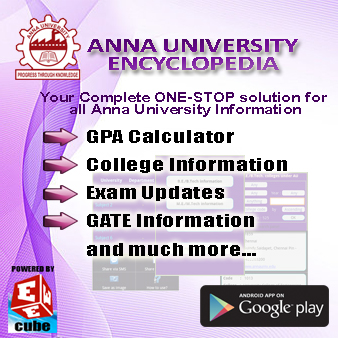SUBJECT RESOURCES:
CLICK HERE to access 'Question Banks'
CLICK HERE to access 'Previous Year Question Papers'
CLICK HERE to access '2 Mark Questions with Answers'
CLICK HERE to access 'Notes'
CLICK HERE to search more about this subject
SYLLABUS:
CLICK HERE to access 'Question Banks'
CLICK HERE to access 'Previous Year Question Papers'
CLICK HERE to access '2 Mark Questions with Answers'
CLICK HERE to access 'Notes'
CLICK HERE to search more about this subject
SYLLABUS:
GE2211 ENVIRONMENTAL SCIENCE AND ENGINEERING L T
P C (Common to EEE, EIE, ICE, Biotech, Chemical, Fashion, Plastic, Polymer & Textile) 3 0 0 3
AIM:
The aim of this course is to create awareness in every engineering graduate about the importance of
environment, the effect of technology on the environment and ecological balance and make him/her
sensitive to the environment problems in every professional endeavour
that he/she participates.
OBJECTIVES:
At the end of this course the student is expected to understand what constitutes the environment,
what are precious resources in the environment, how to conserve these resources, what is the role of a human being in maintaining a clean environment and useful environment for the future
generations and how to maintain ecological balance and preserve bio-diversity.
UNIT I INTRODUCTION TO ENVIRONMENTAL STUDIES AND NATURAL
RESOURCES 9
Definition, Scope and Importance – Need For
Public Awareness – Forest Resources:- Use and Over
- Exploitation, Deforestation, Case Studies, Timber Extraction, Mining, Dams and their Ground
Water, Floods, Drought, Conflicts Over Water, Dams - Benefits and Problems – Mineral Resources:- Use Effects on Forests and Tribal People – Water Resources:- Use and Over-Utilization of Surface and Exploitation, Environmental Effects of Extracting and Using Mineral Resources, Case Studies
– Food Resources: World Food Problems, Changes caused by Agriculture and Overgrazing, Effects of
Modern Agriculture, Fertilizer- Pesticide Problems,
Water Logging, salinity, Case Studies – Energy Resources:- Growing Energy Needs, Renewable and Non Renewable Energy Sources, Use of Alternate Energy
Sources,
Case
Studies
–
Land Resources:- Land
as a Resource,
Land Degradation, Man Induced Landslides, Soil Erosion and Desertification – Role of an Individual in
Conservation of Natural Resources – Equitable use of Resources for Sustainable Lifestyles. Field Study of Local Area to Document Environmental assets – River/Forest/Grassland/Hill/ Mountain.
UNIT II ECOSYSTEMS AND BIODIVERSITY 9
Concepts of an Ecosystem – Structure and Function of an Ecosystem – Producers, Consumers and Decomposers – Energy Flow in the Ecosystem – Ecological Succession – Food Chains, Food Webs
and Ecological Pyramids – Introduction, Types, Characteristic Features, Structure and Function of the (A)
Forest Ecosystem (B) Grassland Ecosystem
(C) Desert Ecosystem
(D) Aquatic Ecosystems (Ponds, Streams, Lakes, Rivers, Oceans, Estuaries)
– Introduction to Biodiversity –
Definition:
Genetic,
Species and Ecosystem Diversity – Biogeographical Classification of India – Value of
Biodiversity: Consumptive Use, Productive Use, Social, Ethical, Aesthetic and Option Values – Biodiversity at Global, National
and Local
Levels – India as a Mega-Diversity Nation – Hot-Spots of Biodiversity – Threats to Biodiversity: Habitat Loss, Poaching of Wildlife, Man-Wildlife Conflicts – endangered and Endemic Species of India – Conservation of Biodiversity:
In-Situ and Ex-Situ conservation of Biodiversity.
Field Study of Common Plants, Insects and Birds - Field Study of Simple Ecosystems – Pond, River,
Hill Slopes, etc.
UNITIII ENVIRONMENTAL POLLUTION 9
Definition – Causes, Effects and Control Measures of:- (A) Air Pollution (B) Water Pollution (C) Soil
Pollution (D) Marine Pollution (E) Noise Pollution (F) Thermal Pollution (G) Nuclear Hazards – Soil Waste Management:- Causes, Effects and Control Measures of Urban and Industrial Wastes – Role of an Individual in Prevention of Pollution – Pollution Case Studies – disaster Management:- Floods,
Earthquake, Cyclone and Landslides.
Field Study of Local Polluted Site – Urban/Rural/Industrial/Agricultural
UNIT IV SOCIAL ISSUES AND THE ENVIRONMENT 9
From Unsustainable To Sustainable Development – Urban Problems Related To energy –
Water
conservation, Rain Water Harvesting, Watershed Management – Resettlement and Rehabilitation of People, Its Problems and Concerns, Case Studies – Environmental
Ethics:- Issues and Possible Solutions – Climate Change, Global Warming, Acid Rain, Ozone Layer Depletion, Nuclear Accidents and Holocaust, Case Studies –
Wasteland Reclamation – Consumerism and
Waste Products – Environment Production Act – Air (Prevention and Control of Pollution) Act –
Water (Prevention and Control of Pollution) Act –
Wildlife Protection Act – Forest Conservation Act – Issues Involved in enforcement of Environmental
Legislation – Public Awareness.
UNIT V HUMAN POPULATION AND THE ENVIRONMENT 9
Population Growth, Variation Among Nations – Population Explosion – Family Welfare Programme –
environment and Human Health – Human Rights – Value Education – HIV /AIDS – Women and
Child Welfare – Role of Information Technology in Environment and Human Health – Case Studies.
L = 45 TOTAL : 45 PERIODS
TEXT BOOKS
1. Masters, G.M., “Introduction to Environmental Engineering and Science”, Pearson Education
Pvt., Ltd., 2nd Edition, 2004.
2. Miller, T.G. Jr., “Environmental Science”, Wadsworth Pub. Co.
3. Townsend C., Harper, J. and Begon, M., “Essentials of Ecology”, Blackwell Science,
2003.
4. Trivedi, R.K., and Goel, P.K., “Introduction to Air
Pollution”, Techno- Science
Publications.
REFERENCES
1. Erach, B., “The Biodiversity of India”, Mapin Publishing Pvt. Ltd., Ahmedabad, India.
2. Trivedi, R.K., “Handbook of Environmental Law’s, Rules, Guidelines, Compliances and
Standards”, Vol -
I and II, Envio Media.
3. Cunningham., Cooper, W.P. and Gorhani, T.H., “Environmental
Encyclopedia”, Jaico
Publishing House, Mumbai, 2001.
4. Wages, K.D., “Environmental
Management”, W.B. Saunders Co., Philadelphia, USA, 1998.
|
|











No comments:
Post a Comment
Note: Only a member of this blog may post a comment.